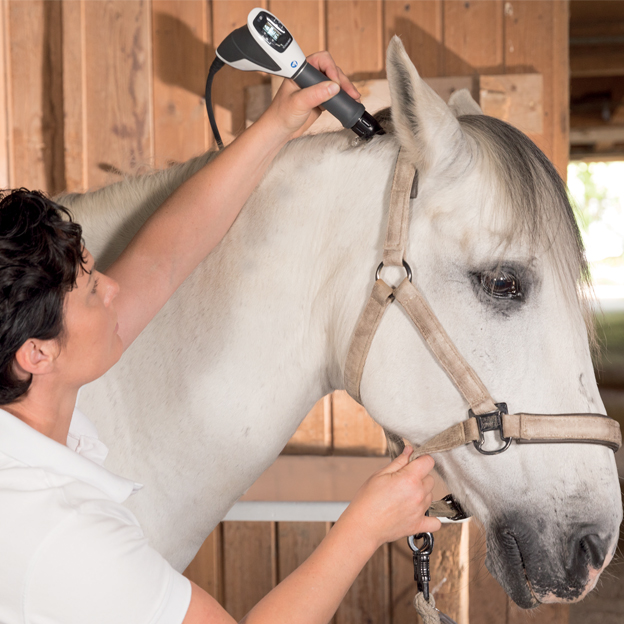Everything You Required to Understand About Equine Therapy for Mental Health And Wellness
Everything You Required to Understand About Equine Therapy for Mental Health And Wellness
Blog Article
How Laser Therapy in Horse Therapy Is Changing Veterinary Look After Equines
Laser therapy has actually emerged as a transformative technique in equine vet treatment, offering a non-invasive solution that expedites healing and boosts total health. The transportability and convenience of laser treatment devices better highlight their growing indispensability among veterinarians.
Recognizing Laser Treatment

The innovation behind laser treatment is grounded in the concept of photochemistry, where photons are taken in by chromophores within cells, resulting in raised ATP manufacturing and modulation of reactive oxygen types (Equine Therapy). This, subsequently, promotes mobile spreading, decreases inflammation, and speeds up recovery. Veterinary experts utilize various kinds of lasers, including low-level lasers (LLLT) and high-power Class IV lasers, relying on the specific restorative goals and the nature of the equine condition being treated
Various laser wavelengths and power settings are thoroughly picked to target various cells midsts and accomplish preferred medical outcomes. Security methods are critical, as inappropriate use can cause thermal damage or suboptimal therapeutic results. Therefore, an extensive understanding of laser treatment's systems and applications is essential for its effective execution in equine veterinary technique.
Advantages for Equine Wellness
The myriad benefits of laser treatment for equine wellness incorporate boosted healing, discomfort decrease, and enhanced flexibility. This sophisticated therapy method leverages specific wavelengths of light to penetrate tissues, stimulating mobile feature and promoting fast tissue repair service. The non-invasive nature of laser therapy makes sure marginal tension and discomfort for the steed, assisting in a smoother healing process.
Enhanced recovery is one of the primary benefits, as laser treatment speeds up cellular regeneration and collagen synthesis. Discomfort reduction is achieved with the anti-inflammatory impacts of laser treatment, which decreases swelling and reduces the manufacturing of pain-inducing chemicals.
Better movement is one more important benefit, specifically for efficiency and functioning equines. By reducing swelling and discomfort, and enhancing tissue repair service, laser treatment aids in restoring joint feature and muscle flexibility. The cumulative effect of these benefits is not just a quicker go back to normal activity however additionally an overall improvement in the equine's quality of life. Therefore, laser therapy stands as a transformative tool in modern horse veterinary treatment.
Usual Problems Dealt With
Laser therapy has emerged as a versatile treatment option for a variety of typical equine conditions. Furthermore, laser treatment is reliable for conditions like osteoarthritis, where it helps reduce joint inflammation and promote tissue repair.
Wound administration is one more area where laser therapy has actually revealed substantial assurance. Persistent wounds or slow-healing abscess can be specifically difficult in equines, but laser therapy enhances cellular regeneration and improves blood flow, hence expediting the recovery procedure. Furthermore, laser therapies have actually been efficiently utilized in handling hoof problems such click as laminitis and abscesses, reducing discomfort and advertising faster recovery.

Modern Technology Behind Laser Treatment
Past the myriad conditions treatable with laser treatment, the modern technology itself qualities more detailed assessment. At the heart of laser treatment is using certain wavelengths of light to pass through cells and evoke organic responses. These wavelengths, generally varying from 600 to 1000 nanometers, are precisely taken in by chromophores in the skin, muscle, and other tissues, initiating a cascade of mobile occasions.
Laser devices made use of in veterinary medication often utilize low-level laser therapy (LLLT) or cold laser treatment. Unlike high-powered surgical lasers, these tools run at lower power levels, enhancing therapeutic benefits while reducing thermal damages. The energy from the laser light promotes adenosine triphosphate (ATP) production, boosts cellular metabolic process, and increases cells fixing processes.

Success Stories and Instance Researches

Showcasing the substantial advantages of laser therapy, various success stories and instance research studies illuminate its transformative effect on equine wellness. One such instance includes a pedigreed racehorse suffering from persistent tendonitis. Standard therapies produced very little improvement, but after incorporating laser treatment into the routine, the horse showed substantial reductions in inflammation and discomfort within weeks, inevitably returning to competitive auto racing.
An additional compelling example features a dressage steed identified with extreme neck and back pain, restricting its efficiency. A vet team utilized low-level laser treatment (LLLT) to target the inflamed areas, leading to significant renovation in versatility and a notable reduction in pain. Over numerous sessions, the horse reclaimed its peak type, showcasing the efficacy of laser therapy in attending to bone and joint problems.
In addition, a research study performed at a leading equine center taken a look at 50 steeds with different soft cells injuries treated with laser treatment. The results were striking: 85% of the horses showed increased healing times and boosted mobility. These cases underscore the flexibility and effectiveness of laser treatment in equine medication, using a non-invasive, scientifically-backed approach to improving recovery and performance in equines.
Final Thought
Laser therapy is reinventing equine veterinary treatment by offering a non-invasive treatment that speeds up recovery, reduces i was reading this swelling, and eases discomfort. With its performance in treating a range of problems, from musculoskeletal injuries to chronic conditions like osteo arthritis, this innovation considerably boosts equine health and mobility. The mobility and adaptability of laser treatment further emphasize its transformative influence on veterinary techniques, strengthening its duty as an essential tool in contemporary equine medical care.
Report this page